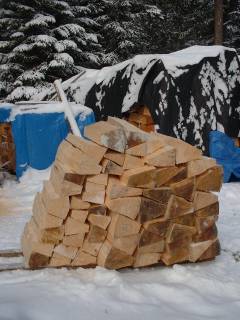Tonewood from the Canadian Rockies
I sell Engelmann Spruce, Western Red Cedar, and Douglas Fir soundboards harvested from the Robson Valley in the east-central region of British Columbia, Canada. I also usually have small quantities of Canadian Cypress (Yellow Cedar), Western White Pine, and SubAlpine Fir (Abies lasiocarpa) soundboards on hand that have been harvested in other areas of BC. In addition, I process high quality logs of Aspen (Populus tremulosus) and White (Paper) Birch (Betula papyrifera) into backs and sides for guitar and violin family instruments.
 All tops are resawn from billets split out of sections of the round log,
to maximize the degree of vertical grain and ensure the sawn surface
follows the natural line of the split to minimize runout. The sawn tops
are stacked and stickered for drying, which might take anywhere from
several days to several months. When the moisture content has
stabilized, the tops are put into inventory for sale. While I usually
have some older soundboards in stock, most tops are not seasoned to any
extent. Master grade material in particular usually goes out as soon as
it is dry
All tops are resawn from billets split out of sections of the round log,
to maximize the degree of vertical grain and ensure the sawn surface
follows the natural line of the split to minimize runout. The sawn tops
are stacked and stickered for drying, which might take anywhere from
several days to several months. When the moisture content has
stabilized, the tops are put into inventory for sale. While I usually
have some older soundboards in stock, most tops are not seasoned to any
extent. Master grade material in particular usually goes out as soon as
it is dry
This wood is grown in the unique northern inland rainforest found in the valleys between the Canadian Rocky Mountains to the east and the Cariboo Mountains to the west. The climatic conditions experienced can be extreme, with temperatures ranging from -40° C. to +35° C., but the deep snows of winter and frequent rainfalls in the summer usually assure good moisture supplies during the growing season. Summer days are long, and wood growth is fast in the early summer while slowing abruptly later in July.
This creates wood with well defined, but narrow, growth rings that is generally lighter in density than wood from the same species grown further south. At the same time, the wood retains its stiffness along the grain while exhibiting superior cross-grain stiffness. Here are some data detailing the measurements I have made on the wood I sell.
Much of this forest is very old, and several of the trees I have processed were over 700 years. While most of the wood I cut is salvaged from dead standing or fallen trees, it is of concern to me that we are not doing enough to ensure a future supply of these high quality old-growth trees for our descendants. While I would like to be able to offer woods certified by the Forest Stewardship Council as grown and harvested in an environentally sustainable manner, there will be no viable supply available in the near future.